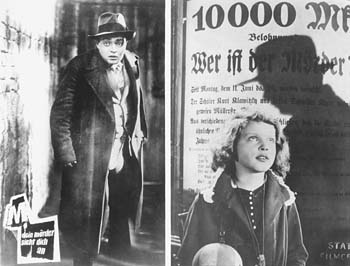The Scarlet Letter
Fritz Lang's haunting Expressionist classic 'M' returns with a vengeance
PETER LORRE'S child-murderer in Fritz Lang's 1931 classic M is introduced with a jump-rope chant, but we don't see him until the film is halfway over. You hear him, you see his shadow against a wanted poster, you see his hands writing a boasting letter to the newspaper. But you don't see him. When he is unearthed at last, he's an abject little man, considerably smaller than life. His cry of "I can't help myself!" rings through decades of movie history.
A restored 35mm print of M has been released, with new subtitles, digital sound and seven minutes restored to the much-censored movie. Like most Expressionist work, it looks many times better on screen than on television.
M is about a murderer who has killed nine children already. Under public pressure, the police are searching for the killer, raiding the slums with such frequency that ordinary crime is disrupted. In many of Lang's films, omniscient gentleman master criminals--particularly Lang's favorite, Dr. Mabuse--run the underworld. These figures, like Holmes' rival Moriarty and James Bond's foe Blofeld, organize crime with the same tidiness that financiers and CEOs rule the daylight world.
In M, the master criminal Schranker calls a meeting of the heads of all of the crime unions in the city to discuss the problem of the police raids. It is decided that the criminals will catch the killer themselves, to ensure business as usual. (They also have a sense of duty--they may be lawbreakers, but they're also parents.)
The complete equality between the cops and the criminals is stressed by Lang, who cuts almost invisibly from the conference tables of one to the conference tables of the other. The criminals are decidedly smarter of the two. When Chief Inspector "Fatty" Lohmann rounds up a bunch of them, they razz him like a rowdy class of high school students greeting a substitute teacher. Later, a criminal says that they're as qualified to judge the killer as the cops: "We are all law experts here."
Much German Expressionist cinema is exciting through set design alone, or by the iconic acting of Louise Brooks, Conrad Veidt or Max Schreck. Lang's compositions have the gut-level impact of tabloid headlines, and his casting is vivid. He shows us as authentic a bunch of whores and pickpockets as has ever been seen in a movie. (According to historian John Eastman, two dozen of Lang's extras were arrested during the filming for various crimes.)
Lang's typically blunt, high-contrast images--a "blind" beggar looking over the top of his smoked glasses to spy on the fugitive, or the close-up of the leather-gloved hand of a police inspector spread flat over a map of the city--alternate with shadows, dim winter light and gray streets. This is what a Batman movie ought to look like! But Lang isn't merely hard-boiled black and very white--the use of almost haikulike symbolism keeps M fresh. We never see a corpse, only a mother calling, a ball rolling without a child to follow it, an abandoned kite caught in the telephone wires.
What makes Lang the master of German Expressionism is the fact that besides the heavy atmosphere, his films move. And in addition to the leanness and speed of his storytelling, Lang's use of sound was five years ahead of his time. In those days of the early talkies, actors and scenes were pinned down into one place by the unwieldy early sound systems. Lang, figuring that the film could be dubbed for the rest of the world, avoided the close-ups on faces and post-synced sound and used long shots for the dialogue scenes.
Lang was a pioneer in using sound to tell a story. We follow the killer through a musical theme. Whenever he's about to strike, he whistles a snatch of "Hall of the Mountain King" from Grieg's Peer Gynt (an opera about an abductor of women--Lang's little joke, and his own whistling recorded on the soundtrack).
Children around the world sing "Just you wait a little while, the Nasty Man in black will come. And with his little chopper, he'll chop you up." But when cornered, Lorre shows what the nasty men in black usually look like in the light of day: helpless, pale, scrabbling for escape, not fit targets for anyone's violence. M is a plea for compassion that, thanks to Lorre's heartbreaking emoting, seems as rousing and logical as most filmmakers' plea for revenge.
The modern film vision of serial killers is of entities who have unlimited money, energy, malice and technology. They can make themselves invisible and walk through walls, courts and prisons. After 66 years, Lorre's pathetic, terrified gaze is still far advanced of what you'd see on screen now, while Hollywood rears up on its tiptoes to show how tall it is standing against crime. M's coda (a troubling voice over a blank screen saying "We must watch our children more carefully") is all the smarter because it doesn't answer the question posed by Lorre's gaze--there's no answer in either the finality of law and no cleansing through a revenge fantasy.
Copyright © Metro Publishing Inc. Maintained by Boulevards New Media.

Enfant Terrible: Peter Lorre is the obsessive child murderer Franz Becker after the young Elsie (Inge Landgut) in Fritz Lang's haunting and newly restored cinematic masterpiece, 'M,' now showing at the Nickelodeon.
M (not rated; 111 min.), directed by Fritz Lang and starring Peter Lorre.
From the Dec. 4-10, 1997 issue of Metro Santa Cruz.
![[MetroActive Movies]](/gifs/movies468.gif)